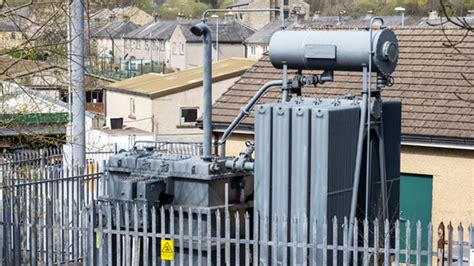
A series of unprecedented fires at eight electrical substations across Britain in just ten weeks has sparked serious concerns about the resilience of the nation’s power grid, with investigations pointing towards faulty equipment rather than malicious interference, including potential Russian sabotage.
LONDON – A spate of fires at eight electrical substations across Britain over the past ten weeks has ignited concerns about the reliability of the nation’s power infrastructure, with initial investigations suggesting that aging or defective equipment is the primary culprit, dispelling early fears of coordinated sabotage. The incidents have prompted urgent reviews of substation maintenance and security protocols, as authorities scramble to prevent further disruptions and reassure the public about the stability of the electricity supply.
The series of incidents began earlier this year, raising immediate alarms within the energy sector and government. The sheer number of simultaneous or near-simultaneous fires led to speculation about potential coordinated attacks, with some commentators even suggesting the involvement of hostile foreign actors. However, as investigations progressed, a more prosaic explanation began to emerge: aging infrastructure and inadequate maintenance are the likely root causes of the substation failures.
“The frequency and geographic spread of these incidents are certainly concerning,” stated a senior official from National Grid, the company responsible for operating and maintaining the UK’s electricity transmission network. “We are working closely with the relevant authorities to fully understand the causes of these fires and to implement measures to prevent similar incidents from happening again.”
The affected substations play a critical role in distributing electricity from power generation plants to homes and businesses across the country. Any disruption to their operation can lead to widespread power outages, impacting essential services such as hospitals, transportation, and communication networks. The economic consequences of such disruptions can also be significant, with businesses forced to shut down and productivity losses mounting rapidly.
While the investigations are ongoing, preliminary findings suggest that several factors may have contributed to the substation fires. These include:
-
Aging infrastructure: Many of Britain’s electrical substations were built decades ago and are now nearing the end of their operational lifespan. Over time, components can degrade, increasing the risk of failure and fire.
-
Inadequate maintenance: Budget cuts and staffing shortages may have led to insufficient maintenance of substations, increasing the likelihood of equipment malfunctions.
-
Extreme weather: Recent heatwaves and storms may have put additional strain on the power grid, exacerbating existing weaknesses in the infrastructure.
-
Component failure: Specific components within the substations, such as transformers or switchgear, may have failed due to manufacturing defects or other factors.
The incidents have prompted calls for increased investment in the modernization of Britain’s power grid. Experts argue that upgrading aging infrastructure is essential to ensure the reliability and security of the electricity supply. They also emphasize the need for improved maintenance practices and enhanced monitoring of substation equipment to detect potential problems before they lead to catastrophic failures.
“These fires are a wake-up call,” said a leading energy analyst. “They highlight the vulnerability of our power grid and the urgent need for investment in infrastructure upgrades. We cannot afford to neglect our energy infrastructure and risk widespread power outages.”
The government has acknowledged the concerns raised by the substation fires and has pledged to take action to address the underlying issues. Energy Minister stated that the government is committed to ensuring the security and reliability of the electricity supply and is working closely with National Grid and other stakeholders to implement the necessary measures.
The minister said, “We are treating these incidents with the utmost seriousness. The safety and security of our energy infrastructure are paramount, and we will take all necessary steps to prevent future disruptions.”
National Grid has also announced a series of measures to improve the resilience of the power grid. These include:
-
Increased inspections: Stepping up inspections of substations to identify potential problems early on.
-
Enhanced monitoring: Implementing advanced monitoring systems to detect equipment malfunctions in real-time.
-
Infrastructure upgrades: Accelerating the replacement of aging equipment with modern, more reliable technology.
-
Improved maintenance: Increasing investment in maintenance programs to ensure that substations are properly maintained.
-
Cybersecurity enhancements: Strengthening cybersecurity measures to protect substations from cyberattacks.
The substation fires have also raised questions about the security of critical infrastructure. While the investigations have not revealed any evidence of sabotage, experts warn that power grids are vulnerable to both physical and cyberattacks. They emphasize the need for enhanced security measures to protect substations from potential threats.
“We must be vigilant in protecting our critical infrastructure from all threats, whether they are physical or cyber,” said a security expert. “Power grids are essential to our economy and way of life, and we cannot allow them to be compromised.”
The investigation into the substation fires is ongoing, and authorities are still working to determine the exact causes of each incident. However, the preliminary findings suggest that aging infrastructure and inadequate maintenance are the primary factors.
The series of fires began drawing public attention when localized power outages began impacting communities. Initially, these were treated as isolated incidents; however, the frequency with which they occurred caused speculation to rise. Social media platforms became rife with theories, ranging from simple equipment malfunctions to elaborate sabotage plots. This prompted official investigations to accelerate in order to determine the cause.
The potential impact of prolonged or widespread power outages has been a significant point of discussion. Hospitals, which rely on uninterrupted power for critical life-support systems, have contingency plans in place, but these are designed for short-term disruptions. Extended outages could overwhelm backup generators and put patients at risk. Similarly, transportation systems, including trains and traffic lights, would face significant challenges, potentially leading to chaos and gridlock.
Businesses, too, would suffer. Manufacturing plants would be forced to halt production, retail stores would be unable to operate, and offices would be paralyzed. The economic cost of such disruptions could run into billions of pounds, with long-term consequences for the UK economy.
One of the key challenges in addressing the issue of aging infrastructure is the cost involved. Upgrading the UK’s power grid would require a massive investment, potentially running into tens of billions of pounds. This raises questions about who should bear the cost: taxpayers, energy companies, or consumers?
Another challenge is the complexity of the power grid itself. Modernizing the grid involves not only replacing aging equipment but also integrating new technologies, such as renewable energy sources and smart grid systems. This requires careful planning and coordination to ensure that the various components of the grid work together seamlessly.
Despite the challenges, experts agree that upgrading the UK’s power grid is essential. They argue that the long-term benefits of a more reliable and secure electricity supply outweigh the costs. They also emphasize the need for a comprehensive plan that addresses all aspects of the power grid, from generation to transmission to distribution.
The current situation has also prompted a wider discussion about energy security in the UK. The country relies heavily on imported energy, making it vulnerable to disruptions in global energy markets. Diversifying energy sources and increasing domestic energy production are seen as key steps towards improving energy security.
In addition to upgrading infrastructure, experts also recommend strengthening cybersecurity measures to protect the power grid from cyberattacks. Cyberattacks can target critical infrastructure, such as power grids, and can have devastating consequences. Strengthening cybersecurity requires a multi-faceted approach, including implementing advanced security technologies, training personnel, and sharing information with other organizations.
“Cybersecurity is a critical component of energy security,” said a cybersecurity expert. “We must be prepared to defend our power grid from cyberattacks and to respond quickly and effectively if an attack occurs.”
The incidents have highlighted the need for greater transparency and accountability in the energy sector. Some critics argue that energy companies have not been transparent enough about the state of their infrastructure and have not been held accountable for their maintenance practices. They call for greater oversight of the energy sector and for stronger penalties for companies that fail to meet their obligations.
The government has responded by announcing a review of the regulatory framework for the energy sector. The review will examine the role of regulators in ensuring the security and reliability of the electricity supply and will consider whether changes are needed to improve oversight and accountability.
The substation fires have also prompted a discussion about the role of renewable energy in the UK’s energy mix. Some argue that increasing the share of renewable energy can improve energy security and reduce reliance on imported fossil fuels. Others caution that renewable energy sources, such as wind and solar, are intermittent and can pose challenges to grid stability.
The government has set ambitious targets for increasing the share of renewable energy in the UK’s energy mix. However, achieving these targets will require significant investment in new renewable energy projects and in grid infrastructure to accommodate the increased flow of renewable energy.
The substation fires serve as a reminder of the importance of investing in critical infrastructure. Neglecting infrastructure can have serious consequences, including power outages, economic disruption, and even threats to public safety. Governments and businesses must prioritize infrastructure investment to ensure the long-term health and prosperity of the nation.
The UK’s reliance on a centralized grid system has also come under scrutiny. Some experts suggest exploring decentralized energy solutions, such as microgrids and community energy projects, as a way to enhance resilience and reduce vulnerability to large-scale disruptions. These smaller, localized systems can operate independently of the main grid, providing a backup power supply in the event of a major outage.
Another area of focus is the development of smart grid technologies. Smart grids use advanced sensors, communication networks, and data analytics to improve the efficiency and reliability of the power grid. They can help to detect and respond to problems more quickly, optimize energy flow, and integrate renewable energy sources more effectively.
The current situation underscores the need for a collaborative approach to energy security. Governments, energy companies, regulators, and consumers must work together to address the challenges facing the energy sector and to ensure a reliable, secure, and sustainable energy supply for the future.
In the wake of these fires, several reports and inquiries have been initiated to thoroughly assess the current state of Britain’s electrical infrastructure. These investigations aim to provide a comprehensive understanding of the factors contributing to the incidents, identify potential vulnerabilities, and recommend measures to strengthen the grid’s resilience.
One key aspect of these inquiries is the examination of maintenance practices employed by energy companies. Critics have argued that cost-cutting measures and a lack of investment in preventative maintenance may have contributed to the deterioration of equipment and increased the risk of failures. The investigations will seek to determine whether maintenance schedules are adequate and whether sufficient resources are being allocated to ensure the proper upkeep of substations.
Another area of focus is the assessment of the age and condition of existing infrastructure. Many of Britain’s substations were built several decades ago and may be nearing the end of their operational lifespan. The investigations will seek to identify substations that are at high risk of failure and to prioritize them for upgrades or replacements.
The inquiries will also examine the role of extreme weather events in contributing to substation failures. Recent heatwaves and storms have put additional strain on the power grid, and the investigations will seek to determine whether the infrastructure is adequately prepared to withstand these types of events.
In addition to these technical aspects, the inquiries will also address the issue of cybersecurity. Power grids are increasingly vulnerable to cyberattacks, and the investigations will seek to assess the effectiveness of existing cybersecurity measures and to identify areas where improvements are needed.
The findings of these inquiries are expected to have a significant impact on the future of Britain’s energy policy. They will likely lead to increased investment in infrastructure upgrades, enhanced maintenance practices, and strengthened cybersecurity measures. They may also prompt a re-evaluation of the regulatory framework for the energy sector and a greater emphasis on energy security.
The government is also considering measures to encourage greater community involvement in energy planning and decision-making. This could include providing communities with more information about energy projects in their area and giving them a greater say in the planning process.
One potential model is the establishment of community energy companies, which would allow local communities to own and operate their own renewable energy projects. These projects could provide a local source of energy and generate revenue for the community.
The government is also exploring ways to encourage greater energy efficiency. This could include providing financial incentives for homeowners to install energy-efficient appliances and insulation, and promoting the use of smart meters to help consumers track their energy consumption.
Another area of focus is the development of energy storage technologies. Energy storage can help to smooth out the fluctuations in renewable energy supply and improve the reliability of the power grid. The government is investing in research and development of energy storage technologies, such as batteries and pumped hydro storage.
Ultimately, the goal is to create a more resilient, secure, and sustainable energy system for the UK. This will require a combination of technological innovation, policy changes, and community involvement.
The incident comes at a critical time, as Britain, like many other nations, is transitioning towards a greener energy future. Integrating renewable energy sources such as wind and solar power presents unique challenges to grid stability. Unlike traditional fossil fuel power plants, renewable energy sources are intermittent, meaning their output varies depending on weather conditions. This variability can make it difficult to match supply with demand, potentially leading to power outages.
To address this challenge, significant investments are needed in grid infrastructure to accommodate the fluctuating output of renewable energy sources. This includes upgrading transmission lines, developing energy storage solutions, and implementing smart grid technologies that can automatically adjust to changes in supply and demand.
The current events highlight the importance of long-term planning and investment in energy infrastructure. Neglecting infrastructure can have serious consequences, not only for the economy but also for public safety and national security.
Frequently Asked Questions (FAQ)
1. What caused the fires at the UK’s electrical substations?
Initial investigations suggest that aging or defective equipment is the primary cause of the fires at eight electrical substations across Britain in just ten weeks. Factors contributing to these incidents include aging infrastructure, inadequate maintenance, extreme weather, and component failure. No evidence of sabotage or coordinated attacks has been found.
2. What is National Grid doing to prevent future incidents?
National Grid is increasing inspections of substations, enhancing monitoring systems, accelerating the replacement of aging equipment, improving maintenance programs, and strengthening cybersecurity measures. These steps aim to identify potential problems early and enhance the grid’s resilience.
3. What is the government’s response to the substation fires?
The government has pledged to ensure the security and reliability of the electricity supply and is working closely with National Grid and other stakeholders. They are treating the incidents with the utmost seriousness and are committed to preventing future disruptions. Additionally, a review of the regulatory framework for the energy sector has been announced.
4. How could widespread power outages impact essential services?
Widespread power outages can impact hospitals, transportation, and communication networks. Hospitals rely on uninterrupted power for life-support systems, transportation systems (trains and traffic lights) would face significant challenges, and businesses would be forced to shut down, leading to economic losses.
5. What are the long-term solutions being considered to improve the UK’s power grid?
Long-term solutions include increasing investment in infrastructure upgrades, enhancing maintenance practices, strengthening cybersecurity measures, diversifying energy sources (including renewable energy), developing smart grid technologies, and exploring decentralized energy solutions like microgrids. A collaborative approach involving governments, energy companies, regulators, and consumers is essential to ensure a reliable and sustainable energy supply for the future.
Expanded Context and Analysis:
The recent series of substation fires in Britain underscores a critical issue facing many developed nations: the aging of essential infrastructure and the potential consequences of neglecting its upkeep. While initial fears of sabotage or external interference dominated the early stages of the investigation, the emerging consensus points to a more mundane, yet equally concerning, reality: the electrical grid, a fundamental pillar of modern society, is showing its age and requires urgent attention.
The UK’s power grid, like those in many other industrialized countries, was largely constructed in the mid-20th century. Decades of operation have taken their toll on the equipment, leading to increased risks of failure and the need for more frequent maintenance. However, budgetary constraints and competing priorities have often resulted in insufficient investment in infrastructure upgrades, leaving the grid vulnerable to disruptions.
The incidents highlight a systemic problem within the energy sector. While energy companies are responsible for maintaining and upgrading their infrastructure, they are also driven by profit motives. This can create a tension between the need to invest in long-term infrastructure improvements and the desire to maximize short-term profits. Regulatory oversight is intended to address this tension, but some critics argue that it has been inadequate, allowing energy companies to prioritize profits over infrastructure maintenance.
The economic implications of neglecting infrastructure are significant. Power outages can disrupt businesses, halt manufacturing, and impact essential services. The cost of these disruptions can run into billions of pounds, and they can also undermine investor confidence and discourage economic growth.
Beyond the economic costs, there are also social and security implications to consider. Power outages can disrupt transportation, communication, and healthcare services, potentially endangering lives. They can also create opportunities for crime and unrest, as people become desperate and vulnerable.
The incidents also raise questions about the resilience of the UK’s power grid to extreme weather events. Climate change is expected to lead to more frequent and intense heatwaves, storms, and floods, which can all put additional strain on the grid. It is essential that the grid be upgraded to withstand these events and that contingency plans be in place to respond to emergencies.
The transition to renewable energy sources also presents new challenges for the power grid. Renewable energy sources, such as wind and solar, are intermittent, meaning their output varies depending on weather conditions. This intermittency can make it difficult to match supply with demand, potentially leading to power outages.
To address this challenge, significant investments are needed in grid infrastructure to accommodate the fluctuating output of renewable energy sources. This includes upgrading transmission lines, developing energy storage solutions, and implementing smart grid technologies that can automatically adjust to changes in supply and demand.
The UK is not alone in facing these challenges. Many other developed nations are grappling with aging infrastructure and the need to transition to cleaner energy sources. The experiences of these nations can provide valuable lessons for the UK as it seeks to modernize its power grid and ensure a reliable, secure, and sustainable energy supply for the future.
One potential solution is to decentralize the power grid. Instead of relying on a few large power plants, the UK could invest in smaller, localized energy sources, such as solar panels on rooftops and small-scale wind turbines. These decentralized sources could provide a more resilient and reliable energy supply, as they would be less vulnerable to large-scale disruptions.
Another potential solution is to improve energy efficiency. By reducing energy consumption, the UK could reduce the strain on the power grid and make it more resilient to disruptions. This could be achieved through a variety of measures, such as improving building insulation, promoting the use of energy-efficient appliances, and encouraging people to use public transportation.
The incidents serve as a wake-up call, highlighting the importance of investing in critical infrastructure and ensuring that it is properly maintained and upgraded. Neglecting infrastructure can have serious consequences for the economy, society, and national security.
The government and energy companies must work together to develop a comprehensive plan to modernize the UK’s power grid and ensure a reliable, secure, and sustainable energy supply for the future. This plan should include investments in infrastructure upgrades, enhanced maintenance practices, strengthened cybersecurity measures, diversified energy sources, smart grid technologies, and energy efficiency measures.
The current events should also serve as a catalyst for greater public awareness and engagement on energy issues. People need to understand the importance of energy security and the challenges facing the energy sector. They also need to be empowered to make informed decisions about their energy consumption and to participate in the development of energy policy.
The UK has the opportunity to be a leader in the development of a modern, resilient, and sustainable energy system. By investing in infrastructure, embracing innovation, and engaging the public, the UK can ensure a reliable and secure energy supply for generations to come.
The investigation into the substation fires is a complex undertaking, involving multiple agencies and experts. The investigation is focusing on a number of key areas, including:
-
Equipment failure: Investigators are examining the equipment at the affected substations to determine whether any of it was faulty or defective. This includes inspecting transformers, switchgear, and other critical components.
-
Maintenance practices: Investigators are reviewing the maintenance records for the affected substations to determine whether they were properly maintained. This includes examining the frequency of inspections, the types of maintenance performed, and the qualifications of the personnel who performed the maintenance.
-
Security measures: Investigators are assessing the security measures at the affected substations to determine whether they were adequate to prevent unauthorized access or tampering. This includes examining the perimeter security, the access control systems, and the surveillance equipment.
-
Cybersecurity: Investigators are examining the cybersecurity measures at the affected substations to determine whether they were vulnerable to cyberattacks. This includes assessing the firewalls, intrusion detection systems, and other security technologies.
-
Environmental factors: Investigators are considering the role of environmental factors, such as weather conditions, in contributing to the fires. This includes examining the temperature, humidity, and wind conditions at the time of the fires.
The investigation is expected to take several months to complete. Once it is finished, the findings will be used to develop recommendations for preventing future substation fires.
In the meantime, the government and energy companies are taking steps to improve the security and reliability of the power grid. These steps include:
-
Increasing inspections of substations: Energy companies are increasing the frequency of inspections of substations to identify potential problems early on.
-
Enhancing monitoring systems: Energy companies are implementing advanced monitoring systems to detect equipment malfunctions in real-time.
-
Upgrading infrastructure: Energy companies are accelerating the replacement of aging equipment with modern, more reliable technology.
-
Improving maintenance: Energy companies are increasing investment in maintenance programs to ensure that substations are properly maintained.
-
Strengthening cybersecurity: Energy companies are strengthening cybersecurity measures to protect substations from cyberattacks.
These efforts are aimed at ensuring that the UK’s power grid remains reliable and secure, even in the face of challenges such as aging infrastructure, extreme weather, and cyberattacks.









